A day trip to Lucca, Tuscany
As I mentioned in my previous post, I recently travelled to Tuscany. Although I had been to Florence several times before, I had never previously ventured out of the Tuscan capital. As well as Firenze (as it’s called in Italian), I also visited Siena, San Gimignano and Lucca. Also known as “Città d’arte” (City of Art), the latter is famous for its intact Renaissance-era city walls which encircle the old town. Nowadays, Lucca has a population of about 89,000 and is the 7th most populous city in Tuscany.
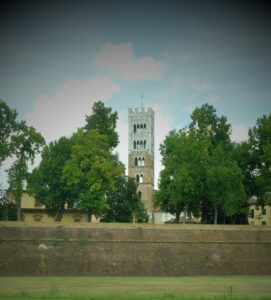
How to get to Lucca
Lucca is easy to reach from Florence by train. The journey takes about an hour and a half, which makes it ideal for a day trip. The train station is located to the south of the old town centre, but just outside the city walls and within walking distance from Porta San Pietro.
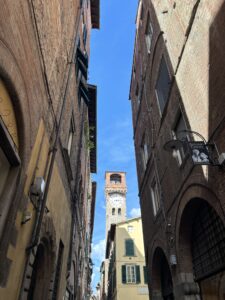
A walking tour in Lucca
When I visited Lucca, I followed the walking tour described below. Starting from Porta San Pietro (south), I walked to the Duomo di San Martino (east), then to Chiesa di San Michele in Foro (west). From there, I walked to the renowned Piazza dell’Anfiteatro (north) and then on the stone-paved Via Fillungo, the main shopping street, in the heart of Lucca.
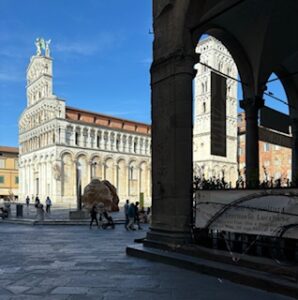
From Porta San Pietro (south) to the Duomo (east)
Once you’ve walked through Porta San Pietro, go left and then turn right on Via San Girolamo. Walk past Chiesa di San Girolamo and you will see Piazza del Giglio on your right and Piazza Napoleone (Piazza Grande) on your left. Afterwards, turn right towards Piazza San Giusto to admire the 12th-century church of the same name. From there, turn right again towards Piazza San Giovanni. If you stay in Lucca overnight, come back to the church of the same name for a concert. Otherwise, continue towards Piazza di San Martino and the town’s cathedral (Duomo di San Martino). Right next to the Duomo, there’s Piazza Antelminelli, and Undici Undici, a lovely bistro where I stopped for a coffee and a light lunch.
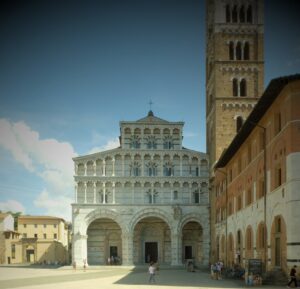
From the Duomo (east) to San Michele (west)
From Piazza Antelminelli, continue on Via delle Trombe. Chiesa della Santissima Annunziata dei Servi will be on your right. On your left, you will come across Piazza Bernardini. Turn left on Via Santa Croce and walk towards Via Fillungo, the main shopping street. Continue to Piazza San Michele to admire the beautiful façade of the church of the same name (free to enter).
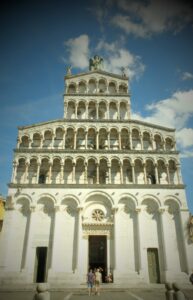
From San Michele (west) to Piazza dell’Anfiteatro (north)
Afterwards, continue on Via Calderia towards Piazza del Salvatore. Chiesa di San Salvatore is much smaller than Chiesa di San Michele in Foro, but it is also free to enter.
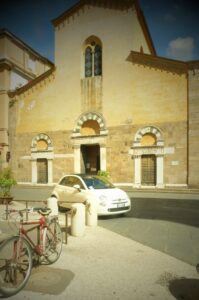
Two more churches, Chiesa Santa Maria Corteorlandini and Chiesa di Sant’Agostino, are not far from there. The latter is free to enter and is right next to Palazzo Pfanner, another place where concerts take place (in case you decide to spend the night in Lucca). Nowadays, Palazzo Pfanner is home to a museum of art and artefacts. Continue towards Basilica di San Frediano, situated on the piazza of the same name. On the opposite side of Piazza di San Frediano, there’s Via Fillungo. The oval-shaped is hidden on the other side of Via Fillungo.
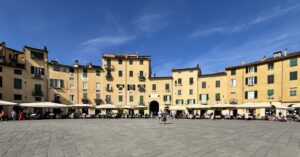
From Piazza dell’Anfiteatro (north) to Via Fillungo (centre)
Exit Piazza dell’Anfiteatro from the east side and continue on Via Canuleia. As you walk on Via Canuleia, you will undoubtedly notice the 14th-century Torre Guinigi. Continue to Piazza del Suffragio to admire the Monument to Luigi Boccherini opposite Chiesa di Santa Giulia. Born in Lucca in 1743, Boccherini was a composer and cellist best known for a minuet from his String Quintet in E. From there, continue on Via del Suffragio and Via Arancio towards the intersection with Via Fillungo. On your right-hand side, there’s Torre delle Ore, whereas Chiesa di San Cristoforo is on Via Fillungo, not far from the intersection with Via Santa Croce.
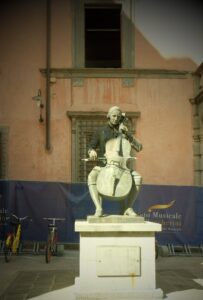
Further reading
To better prepare for my trip in Tuscany, I used the Lonely Planet Italy Travel Guide.
Over the next few months, I will post more about Florence and Siena. In the meantime, here is an older post about Florence:
Summer in Florence: top 7 tips
and my recent post about San Gimignano:
A day trip to San Gimignano, Tuscany
Buon viaggio!
Alex
(the Traveling Psychiatrist)